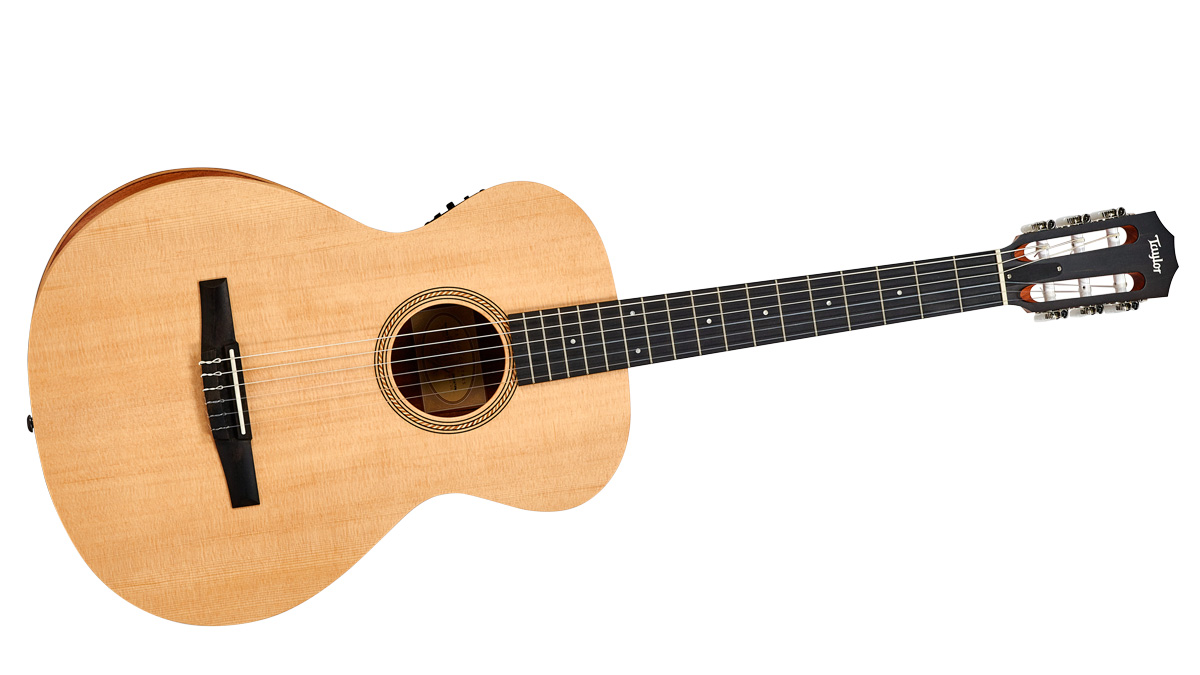MusicRadar Verdict
A fine guitar, but it comes at a price.
Pros
- +
Typically precise Taylor design and build; crisp classical- style voicing, excellent plugged in.
Cons
- -
Basic preamp and almost overly austere construction, especially considering the price.
MusicRadar's got your back
Taylor Academy’s proposition is proper guitars for - in Taylor terms - not a lot of money: making the “acoustic guitar accessible to more players”.
This nylon string is also, by design, aimed at the younger starter player. It might be entry level in terms of Taylor’s range but, not least in this nylon electro form, it’s hardly low-end with serious competition from the likes of Yamaha and Cordoba, who have ‘posher’ spec’d nylon electros at the same, or lower, price-points.
Taylor’s smallest full-scale shape, the Grand Concert, is the perfect size for a ‘classical’ nylon-string. The 12e-N falls, slightly, into the ‘crossover’ style, not least with its ES-N under- saddle and small-footprint basic preamp, lightly cambered fingerboard and relatively narrow neck. That said, its full depth and non-cutaway style, not to mention its dot inlaid fingerboard, makes it look more like a 00/000 with the ‘wrong’ strings. In typical Taylor style, however, its build is as clean as a whistle.
The satin varnish finish is about as thin as it gets which will no doubt enhance its resonance though it provides little protection; the back of the mahogany neck (with separate head and heel block) and the sapele veneers have an almost open-pore textural feel.
We do get an adjustable truss rod - not part of traditional classicals - and strap buttons on both heel and base, the latter doubling as the output jack which is firmly screwed in place. Along with the classical-style tuners, the tie-block bridge is classy; the slightly compensated Tusq saddle angled back to ensure good down pressure over the under-saddle transducer. Fretting too is superbly consistent.
Sounds and feel
The Taylor is set a shade under 3mm on the trebles and bang on 3mm on the bass side. The Taylor’s voice is classical with an open midrange; hit hard it has an almost flamenco-like character yet played in a more relaxed Latin-style its voicing allows clear representation of the often complex jazzier chords of that genre.
The guitar’s tuners - machineheads and the onboard digital tuner - work efficiently. The latter is extremely handy on a nylon string, as they take more time to settle to consistent pitch compared to steel.
Plugged in, we really can’t fault the Taylor; it is crisp, balanced and with a low end that won’t run away with you. Onstage you might rely on a floor tuner or outboard preamps, which suits the simplistic Taylor. The Taylor’s soundhole is circular and will take a soundhole bung.
There are very few negatives. The Taylor impesses in terms of neck shape, size, playability and comes with a crisp, defined voicing. It comes at a price though, bringing in some serious competition.
As ever, if you’re new to the parallel universe of the nylon string: play as many as you can and find your fit.
Dave Burrluck is one of the world’s most experienced guitar journalists, who started writing back in the '80s for International Musician and Recording World, co-founded The Guitar Magazine and has been the Gear Reviews Editor of Guitarist magazine for the past two decades. Along the way, Dave has been the sole author of The PRS Guitar Book and The Player's Guide to Guitar Maintenance as well as contributing to numerous other books on the electric guitar. Dave is an active gigging and recording musician and still finds time to make, repair and mod guitars, not least for Guitarist’s The Mod Squad.
“Excels at unique modulated timbres, atonal drones and microtonal sequences that reinvent themselves each time you dare to touch the synth”: Soma Laboratories Lyra-4 review
“I used everything I knew about music”: How Green Day exceeded expectations with their most ambitious song
YouTube just added AI tools that makes musicians, library music and video editors redundant











